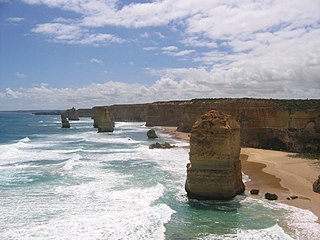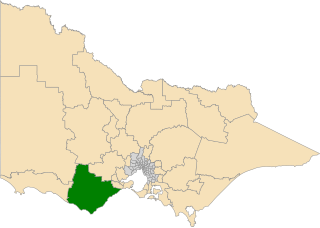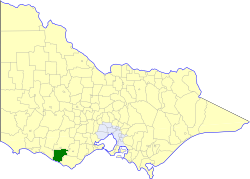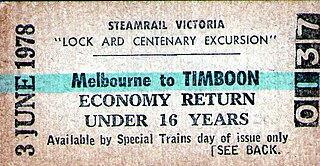
Peterborough is a town on the Great Ocean Road in Victoria, Australia, approximately three hours' drive from Melbourne. The town is situated on land to the west side of the mouth of the Curdies River.

Baron Sir Ferdinand Jacob Heinrich von Mueller, was a German-Australian physician, geographer, and most notably, a botanist. He was appointed government botanist for the then colony of Victoria (Australia) by Governor Charles La Trobe in 1853, and later director of the Royal Botanic Gardens, Melbourne. He also founded the National Herbarium of Victoria. He named many Australian plants.

The Western District comprises western regions of the Australian state of Victoria. It is said to be an ill–defined district, sometimes incorrectly referred to as an economic region,. The district is located within parts of the Barwon South West and the Grampians regions; extending from the south-west corner of the state to Ballarat in the east and as far north as Ararat. The district is bounded by the Wimmera district in the north, by the Goldfields district in the east, by Bass Strait and the Southern Ocean in the south, and by the South Australian border in the west. The district is well known for the production of wool. The most populated city in the Western District is the Ballarat region, with 96,940 inhabitants.
Lara is a town in Victoria, 18 km north-east of the Geelong CBD, inland from the Princes Freeway to Melbourne. Its population at the 2016 census was 16,355.

Sir Charles Sladen,, Australian colonial politician, was the 6th Premier of Victoria.

Terang railway station is located on the Warrnambool line in Victoria, Australia. It serves the town of Terang, and it opened on 23 April 1887.

Camperdown is a town in southwestern Victoria, Australia, 190 kilometres (120 mi) west of the state capital, Melbourne. At the 2016 census, Camperdown had a population of 3,369.

Cobden is a town located 200 kilometres southwest of Melbourne, Victoria, Australia named in honour of Richard Cobden. At the 2006 census, Cobden had a population of 1,813. At the 2001 census, Cobden had a population of 1,419.

Inverleigh is a town in Victoria, Australia located 28 kilometres (17 mi) west from the City of Geelong and 87 kilometres (54 mi) from the state capital, Melbourne. The town is divided between Golden Plains Shire and Surf Coast Shire. In the 2021 census, the central area of Inverleigh had a population of 1,746. Inverleigh is known to be a popular stopover destination on the way to Lorne. The Inverleigh Hotel is very popular attracting customers from Geelong.

The electoral district of Polwarth is an electoral district of the Victorian Legislative Assembly. It is located in south-west rural Victoria, west of Geelong, and covers the Colac and Corangamite local government areas (LGA), parts of the Moyne, Golden Plains and Surf Coast LGAs, and slivers of the Ararat and Greater Geelong LGAs, running along the Great Ocean Road taking in Anglesea, Cape Otway, Peterborough, Aireys Inlet, Lorne, Wye River, Apollo Bay and Port Campbell, covering the inland towns of Winchelsea, Colac, Camperdown and Terang along the Princes Highway, and Inverleigh, Cressy, Lismore and Mortlake on the Hamilton Highway, and finally, includes the Otway Ranges and Lake Corangamite.

Ken Hinkley is the senior coach of the Port Adelaide Football Club in the Australian Football League (AFL) and a former player with the Geelong Football Club and Fitzroy Football Club.

Timboon is a town in the Western District of Victoria, Australia. The town is in the Shire of Corangamite local government area, and is approximately 213 kilometres (132 mi) south-west of the state capital, Melbourne. At the 2001 census, Timboon had a population of 787. At the 2006 census, Timboon had a population of 871. During the 2016 census Timboon had a population of 1,202.

The Shire of Heytesbury was a local government area about 200 kilometres (124 mi) west-southwest of Melbourne, the state capital of Victoria, Australia. The shire covered an area of 1,558.39 square kilometres (601.7 sq mi), and existed from 1895 until 1994.

The Warrnambool railway line is a railway serving the south west of Victoria, Australia. Running from the western Melbourne suburb of Newport through the cities of Geelong and Warrnambool, the line once terminated at the coastal town of Port Fairy before being truncated to Dennington. This closed section of line has been converted into the 37 km long Port Fairy to Warrnambool Rail Trail. The line continues to see both passenger and freight services today.

The City of Geelong West was a local government area about 5 kilometres (3 mi) west of the regional city of Geelong, Victoria, Australia. The city covered an area of 5.26 square kilometres (2.0 sq mi), and existed from 1875 until 1993.

The Timboon railway line is a closed railway line, in Victoria, Australia, which branched from the Port Fairy line, near Camperdown, and served the towns of Cobden and Timboon, along with the farming communities of the area.

The Camperdown Football Netball Club, nicknamed the Magpies, is an Australian rules football and netball club based in the town of Camperdown, Victoria.
Leonard Joseph White was an Australian rules footballer who played with Geelong in the Victorian Football League (VFL).
Sir (Thomas) Chester Manifold was prominent member of the Victorian Racing community as a successful racehorse owner and breeder. He also spent 6 years as an Victorian politician.
James Curdie MacKinnon was an Australian first-class cricketer.
















